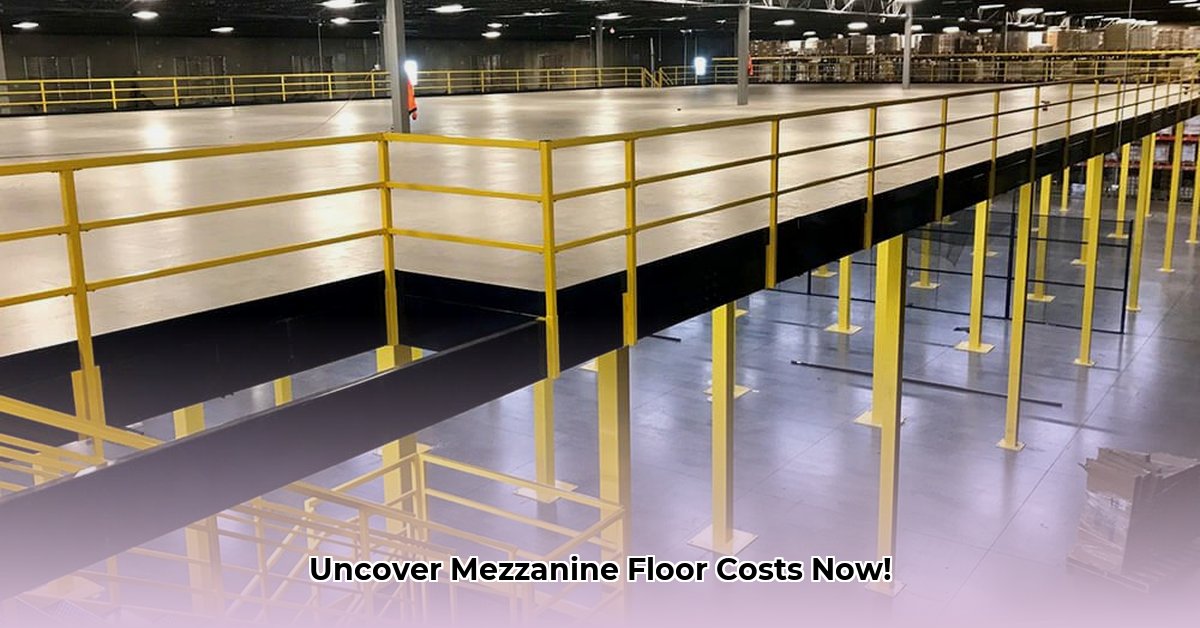Thinking about adding a mezzanine floor to your home or business? Understanding the costs involved is the crucial first step. This guide provides a clear roadmap to navigate the complexities of mezzanine floor pricing, helping you make informed decisions and avoid unexpected expenses. For more detailed cost analysis, check out this helpful resource on mezzanine floor costs. Whether you’re aiming for extra storage space or expanding your operational footprint, let’s get started on understanding mezzanine costs.
Understanding Mezzanine Floor Costs: A Breakdown
Adding a mezzanine floor is similar to buying a house; a basic commercial steel mezzanine floor typically ranges from $40 to $60 per square foot, while wood mezzanines can range from $50 to $75 per square foot. These costs can fluctuate based on size, materials, and complexity. For instance, a residential project around 250 square feet might average $12,500, but a custom design will inevitably increase expenses. Think about the long-term value when considering the initial investment; what is the ultimate goal of your mezzanine project?
Key Factors Influencing Price: Size, Materials, Design and More
Several key factors can significantly influence the final mezzanine floor cost. Understanding these elements helps in accurate budgeting.
- Size Matters: Larger mezzanines increase the overall investment, though the cost per square foot may decrease due to economies of scale.
- Material Choices: Steel offers durability and cost-effectiveness, while wood provides aesthetic flexibility. The overall price will depend on the type and finish selected. Other materials like aluminum or concrete will also impact the cost.
- Design Complexity: Simple, rectangular designs are more cost-effective than complex, custom builds. Features like integrated staircases, lifts, or specialized railings will impact pricing.
- Location, Location, Location: Labor and material costs vary by region, influencing overall expenditure. Metropolitan areas or regions with specialized labor may see higher costs.
- Load Requirements: The intended use of your mezzanine dictates its load-bearing needs. Heavier loads require sturdier construction, thus impacting material and labor costs.
- Permits and Regulations: Budget for permits and inspections to ensure compliance with local building codes and standards.
- Fancy Extras: Custom staircases, fire suppression systems, specialized lighting, and unique finishes can significantly increase the price.
Considering these aspects, how can you balance desired features with budget constraints? Accurate planning will keep your project cost-effective.
Getting Accurate Quotes: Tips for Homeowners and Business Owners
Obtaining multiple quotes from different contractors—at least three—is crucial to ensure you receive a fair price. When contacting contractors, provide clear specifications regarding size, materials, design features, load requirements, and intended usage to ensure accurate and comparable estimates. This helps you compare apples to apples efficiently and avoid misunderstandings down the road. Be prepared to provide blueprints or detailed sketches if possible.
Preparing for Your Mezzanine Installation: Permits and Logistics
Before starting any construction, certain essential steps are needed for a smooth mezzanine installation. Careful preparation is key to keeping your project on track and within budget, ensuring everything aligns with expectations and regulations.
- Site Assessment: A professional should assess your building to ensure it can support the mezzanine’s weight and that the existing structure meets code for the intended load.
- Permitting: Obtain all necessary building permits to avoid delays and potential fines. Local regulations vary, so research requirements early in the process.
- Design Finalization: Finalize dimensions, materials, and features. Having a detailed design prevents change orders and unexpected costs.
- Contractor Selection: Choose an experienced and transparent contractor. Check references and verify licenses and insurance.
- Timeline: Set a realistic project timeline. Delays can lead to increased labor costs and material storage fees.
- Accessibility: Ensure adequate accessibility to the site for material delivery and construction equipment. Limited accessibility can increase labor time and equipment costs.
Budget Planning and Cost Management: Avoiding Overruns
To protect yourself from unexpected expenses, always include a contingency buffer—10-15% of your total estimated cost—when planning your budget. This proactive approach ensures that you’re ready to handle any surprises that may arise during the project, such as unexpected structural issues or material price increases. Are you prepared to absorb unexpected construction costs, or is a contingency plan a must?
Finding the Right Contractor: Choosing Expertise and Reliability
Selecting the right contractor is a critical factor that can make or break your mezzanine project. When evaluating potential contractors, consider the following:
- Extensive Experience: Look for a proven track record of successful mezzanine installations, preferably with projects similar in scope and complexity to yours.
- Insurance and Licensing: Ensure they are fully insured and licensed to protect against liabilities. Verify the validity of their credentials with local authorities.
- Client Testimonials: Contact previous clients for insights and honesty. Ask about their experience with communication, problem-solving, and adherence to budget and timeline.
- Transparent Communication: A contractor should communicate honestly and openly throughout the process, providing regular updates and addressing any concerns promptly.
- Detailed Contract: Ensure the contract clearly outlines project scope, payment schedule, change order procedures, and warranty information.
Sample Cost Breakdown (Commercial Projects): A Ballpark Figure
The table below provides general insight into commercial mezzanine costs; note that the actual costs will vary based on project specifics.
| Feature | Cost Range Per Square Foot ($) |
|---|---|
| Basic Steel Mezzanine | 40 – 60 |
| Wood Mezzanine | 50 – 75 |
| Complex Custom Design | 75 – 150+ |
This guide offers a foundational understanding of mezzanine floor pricing. For larger projects, consulting a structural engineer and a reputable contractor is highly recommended.
How to Get Accurate Mezzanine Installation Cost Estimates for Complex Designs
Mezzanine costs vary widely, ranging from $40 to over $150 per square foot, with complexities significantly driving up prices. Key factors include size, materials, design intricacy, load capacity, specialized features (lifts, staircases), and location. Therefore, obtaining multiple quotes and thorough planning are crucial to minimize surprises and overruns.
Deciphering the Maze of Mezzanine Costs
Gaining an accurate cost estimate for a complex mezzanine design can be straightforward by breaking down the process into manageable steps. Understanding the influencing factors makes it less daunting and allows you to budget effectively.
Key Factors Driving Up (or Down) Your Costs
Think of the mezzanine’s cost as a layered cake, where each component affects the final price.
- Size: Larger projects increase total costs but can reduce per-square-foot expenses. Carefully consider your space needs to avoid overbuilding.
- Materials: Steel, aluminum, and wood have different pricing implications when weighing choices against durability and aesthetics when selecting materials. Consider recycled or reclaimed materials for cost savings and environmental benefits.
- Design: Intricate builds will increase expenses compared to simple designs. Value engineering during the design phase can identify cost-saving opportunities without compromising functionality.
- Load Capacity: Higher capacities need stronger materials, driving up expenses. Accurately assess your load requirements to avoid over-engineering.
- Location: Regional labor costs affect project expenses. Consider contractors located outside major metropolitan areas for potentially lower labor rates.
- Accessibility: Difficult site access can increase labor and equipment costs. Factor in potential challenges related to site access during the planning phase.
- Custom Features: Lifts, specialized staircases, and unique finishes add to the overall cost. Prioritize essential features and explore cost-effective alternatives for non-essential elements.
How to Get Accurate Mezzanine Installation Cost Estimates for Complex Designs: A Step-by-Step Guide
- Detailed Plans: Generate comprehensive blueprints and specifications to avoid costly revisions. Include all structural details, material specifications, and feature requirements.
- Material Selection: Balance cost with sustainability and durability. Research different material options and their associated costs and benefits.
- Multiple Quotes: Acquire at least three quotes that include the same scope. Provide all contractors with the same detailed plans and specifications to ensure accurate comparisons.
- Contractor Vetting: Verify references, licenses, and experience with complex builds. Ask contractors for examples of similar projects they have completed and contact references to assess their performance.
- Contract Review: Scrutinize payment schedules and warranty details. Ensure the contract clearly defines payment milestones, change order procedures, and warranty coverage.
- Contingency Planning: Prepare a budget buffer for unexpected costs. A contingency fund of 10-15% is recommended to cover unforeseen expenses.
- Value Engineering: Explore cost-saving alternatives without compromising quality or functionality. Identify areas where design or material modifications can reduce costs.
Budgeting and Cost Management: Avoiding Cost Overruns
Strategic cost management relies on accurate budgeting that will help you stay on track.
- Phase your Project: Breaking down the project into smaller phases allows for better cost control. Prioritize essential phases and defer non-essential work to later stages.
- Track Expenses: Detail any expenditures to identify potential overruns quickly. Use project management software or spreadsheets to track all costs and compare them to the budget.
- Regular Communication: Maintain open discussions with your contractor and promptly communicate changes. Frequent communication helps identify and address potential issues early on.
Finding the Right Contractor
- Glass Wall Tile Ideas for Kitchens and Bathrooms - December 6, 2025
- Glass Tile Bathroom: Create a Beautiful, Easy-Clean Space - December 5, 2025
- Glass Tile: Brighten Your Home With Stylish Glass Backsplashes - December 3, 2025










